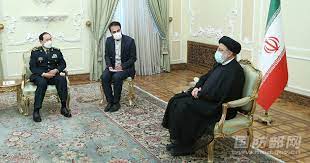Chinese minister of national defense Wei Fenghe visited Tehran on 27 April 2022 and met with high profile personalities of Iran. Wei Fenghe expressed that Iran sees China as a strategic partner. The close cooperation of both countries would provide security, particularly in the current critical and tense situation. The intentions of both countries demonstrate that their cooperation may lead towards deep strategic cooperation.
After meeting with President Ebrahim Reisi, the two sides agreed to expand all areas of cooperation, including the military, while reiterating their shared commitment to protecting fundamental interests, gainst what they called the West’s “unilateral, domination and external intervention.” Admittedly, it emphasizes mutual inattention. After meeting with AFGS, the two countries “agreed to enhance bilateral cooperation in joint military exercises, exchange of strategies, training matters and other common areas.”
Due to Iranian Armed Forces Cihef of Staff Maj Gen Hossein Bagheri’s strong defense diplomacy, Iran’s relations with the Chinese People’s Liberation Army (PLA) have become closer in recent years. In 2019, General Bagheri became the first Iranian armed forces chief of staff to visit China since the 1979 Islamic Revolution.
In addition, Wei Feng’s was the third high-level PLA delegation to visit Iran since 2016, which coincided with General Bagheri’s appointment as head of the Iranian armed forces. It shows that there is more going on below the surface.
China has reaffirmed its commitment to peace and security in the Middle East and the Gulf. At the same time, he criticized the USA for imposing unilateral sanctions on Iran and proposed a series of forgotten alternative security frameworks for the Gulf, which undermined the US-led security umbrella in the region. It may ensure the prosperity of Beijing and the free flow of oil.
China has been considered suspicious of arms supply to Iran during the sanctions and it also has been cautious with Iran over the UN arms embargo, which was in effect until October 2020. Once sanctions are lifted, private and state-owned companies may seek to diversify their portfolios by selling military assets. China was the largest supplier of weapons to both sides during Iran-Iraq war, they bought more than $7.5 billion worth of arms in the late 1980s. According to the Stockholm International Peace Research Institute, China took advantage of a flaw in pre-2006 orders to continue supplying weapons to Iran after the years of sanctions. These weapons were anti-ship missiles, surface-to-air missiles; armored personnel carriers, surface-to-air missile systems, air search radar and missile launch catamarans systems, which reached Iran.
In recent years, Iran has used its control over this strategic barrier of the Strait of Hormuz, through which one-fifth of the world’s oil passes, to attack passing tankers and shoot down US drones. For their own reasons, China and Iran are trying to develop A2/AD capabilities on their shores to counter US and allied navies. Both countries practice downing US aircraft carriers in mock-ups. He has also helped develop long-range anti-ship missiles, demonstrating how Chinese companies can boost Iran’s development of indigenous weapons.
In March 2010, it was reported that Iran had begun manufacturing Chinese-designed Nasr-1 anti-ship missiles. Just four years ago, during the 2006 Lebanon war, four Israeli navy soldiers were killed by an Iranian derivative of a Chinese C-802 subsonic anti-ship cruise missile launched by the Iranian proxy Hezbollah.
Since the lifting of sanctions in 2020, bilateral arms purchases have not been reported, possibly due to Tehran’s economic woes and the possible backlash from Iran’s rivals (especially through US Executive Order 13949). But Iran’s defense industry is showing interest in Chinese weapons, especially fighter jets. The possibility of future deployment of Chinese J-10 fighter jets in the Persian Gulf was raised by former US Secretary of State Mike Pompeo, and there is no question of a jet trade for energy.
With the possibility of a resumption of the nuclear deal, it may allow Tehran to gain greater access to funds, which could lead to a growing concern for the arms trade among Washington and its allies. Some analysts have ruled out the possibility of China becoming a major arms exporter to Iran in the post-sanctions period, but as the Lebanon war and recent bombings have made clear, Chinese technology is in the wrong hands
Drones, dual-use and missile technology are also of concern. Unlike other major arms suppliers in the region, China is not a party to the Wassenaar Agreement, which could make it the largest supplier of armed drones in the Middle East Region.
Because Iran can manufacture its drones locally, Tehran’s opponents currently use Chinese drones exclusively. Reports have revealed Chinese support for the local production of unmanned aerial vehicles (UAVs) in the Gulf States, including a recent joint venture between China and Saudi Arabia to develop military drones in the kingdom. Given China’s high-quality, low-cost drones, as well as its ability to transfer knowledge and upgrade Iranian UAVs, the possibility of bilateral cooperation in this emerging field cannot be ruled out.
In January 2021, Beijing sources confirmed that Iran and Pakistan had gained access to China’s BeiDou satellite navigation system for military purposes. Although current Iranian ballistic missiles rely on guidance methods rather than satellites, BeiDou can help the Iranian armed forces determine launch locations and target positions, especially with intelligence support and other strategies. In contrast, satellite navigation is suitable for controlling surface-to-surface ballistic missiles, cruise missiles and drones within a range of 500 km.
During the recent years, both the countries have increased their military cooperation with their navies visiting each other’s seaports and organized joint naval drilling in the Indian Ocean. In March 2021, China and Iran signed a 25-years strategic cooperation agreement. It also covers all varieties of cooperation and economic activities from oil and mining to establishment of industries in Iran.
The improvement of strategic and defense cooperation between China and Iran would have a remarkable impact in diffusing unilateralism and fighting terrorism in the region.























